Boeing B-52 Stratofortress. Half a century in service (part of 3)
Beginning with 1972, the X-NUMX B-281G / H aircraft was modified to install a Boeing AGM-52A (SRAM - Short-Range Attack Missile) short-range SD with a nuclear warhead, which was primarily intended to suppress enemy's anti-aircraft weapons , but could also be used to defeat poorly and moderately protected strategic targets. One aircraft could carry up to 69 UR AGM-20A (eight on a drum launcher in the armament compartment and six on each of the two underwing pylons). early 69-s SRAM missiles were decommissioned due to the expiration of storage periods.
The first successful launch of the ALCM CD (Air-Launched Cruise Missile) from the B-52 aircraft took place on 5 in March on 1976, and in 1981-1990 on. 195 airplanes (99 B-52G and 96 B-52H) were modified to install twelve (six on each under-roof pylon) Boeing AGM-86B CU with a nuclear warhead. 1988-1993 The 96 aircraft B-52H are additionally modified to accommodate up to eight AGM-86B CRs on a unified drum PU and, thus, one В-52Н can carry up to 20 KR (which gives a maximum combat load of about 29 tons). Beginning with 1990, the 500 built a series of advanced, low-profile CG General Dynamics AGM-129 (ACM - Advanced Cruise Missile), which B-52H can carry (B-52G does not have this ability). The weight of the underwing pylon for the CD is about 2270 kg. After starting the CR pylons can be reset.
common weapon includes free-fall bombs (SPB): Mk.82 (caliber 227 kg), M117 (340 kg), Mk.83 (454 kg) and Mk.84 (907 kg), planning bombs GBU-15 and is located in the weapons compartment, and also (on variants B-52D, F, G and H) on two underwing pylons. The armament compartment can usually be suspended up to 27 340 caliber bombs, and on external pylons up to 24 340 kg bombs, which gives the total 19,0 combat load, taking into account the actual mass of the bombs. Typical normal combat load includes 24 bombs Mk.82 / M117 or eight bombs Mk.84, located in the weapons compartment. During the Vietnam War, the B-52D aircraft were modified using the Big Belly program to increase the load in the armament compartment to 42 bombs of 340 caliber kg or to 84 bombs of 227 kg, which gives the maximum total 29,2 t load . The accuracy of low-altitude bombing depends largely on the skill of the crew and reaches 9 m in training flights.
At the end of the 1980-s, 69 from the 167 that remained in service with the B-52G aircraft were re-targeted to perform long-range operations using non-nuclear weapons and, starting from 1988, equipped with an integrated conventional weapon control system (ICSMS), allowing the use of nuclear weapons. They can perform offshore operations with weapons from McDonnell-Douglas AGM-84 “Harpoon” anti-shipboard missile system (up to 12 SD on the external suspension of one aircraft) and mines. For destruction of ground targets, the aircraft are armed with high-precision SD Martin-Marietta AGM-142 “Hev NEP” with the T guidance system (produced in the USA by the Popei missile developed in Israel; 300 KG UR “Hev Nep” mass, launch range 110 km) and CR AGM-86C with a non-nuclear warhead. It was also supposed to arm the B-52G and anti-radar UR Northrop AGM-136 "Tesit Rainbow" (on the new 30-charging rotating PU), but the development of this missile was discontinued in 1991.
Of the 95 B-52H, which will remain in service with the US Air Force in 1990's, the 47 aircraft will be re-equipped to use precision-guided conventional weapons, the rest will carry nuclear weapons. Conversion of the B-52H is carried out using components from the B-52G that are being decommissioned. It began in 1993 and will last for several years. The modification of the first B-52Н was completed in September of 1993, in 1994 it was planned to re-equip 10 airplanes. Planned modifications include the installation of satellite navigation system receivers, a noise-resistant communication system, a universal adapter in the bomb bay and an integrated control system for conventional weapons. Underwing holders will be installed (shot directly from the B-52 G), allowing bombs to be hung up to 907 kg in size. 18 aircraft will be modified for the suspension under the wing of anti-ship missiles AGM-84 "Harpoon" (up to 12 missiles), and 10 aircraft can carry missiles AGM-142 "Hev NEP" (up to four). On 47 aircraft B-52H with conventional weapons is also planned installation of adjustable bombs JDAM. B-52H can also carry AGM-86 cruise missiles, including AGM-86C non-nuclear missiles.
Small defensive armament is located on the tail turret and includes on versions from B-52A to B-52G inclusive four Browning MZ machine guns (12,7 mm, 4XXNNXX ammunition; on B-600G - with radar fire control system AN / ASG-52), to XNXX B / RB-15B aircraft - two М33А52 guns (24 mm) and В-1Н - one М20А52 gun gun (61 mm, 1 cartridges) on turrets of General Electric T20 with radar remote control system AN / AS / AS.
B-52G / H specifications
dimensions. Wingspan 56,39 m; length of the aircraft 49,05 m; 12,40 aircraft height m; Wing area 371,60 m2; wing sweep angle along the 1 / 4 line of 35 ° chords.
Engines. On B-52H: Pratt-Whitney TRDC TF33-P-3 (8x75,6 kN, 8x7710 kgf); on B-52G: TRD Pratg-Whitney J57-P-43WB (8x49,8 / 8x61,2 kN, 8X5080 / 8X6240 kgf without / with water-methanol injection).
Masses and loads kg: maximum flight weight (after refueling in air) 256735 kg (B-52Н); maximum take-off weight 229065 (В-52Н) or 221355 (B-52G); empty curb weight of the aircraft (B-52G) with a crew of 6 people. - 83460; construction weight (B-52G) 37440; landing weight - (B-52G): maximum 147420, maximum operating 131540; maximum combat load in the 22680 armament compartment (B-52H); fuel stock (produced): in internal 135825 tanks (l. 174130), in suspended tanks. 4135 (l. 2x2650).
flight data. Maximum horizontal flight speed at high altitude 957 km / h (M-0,9); cruise number M at high altitude: maximum 0,84 (instrument 723 km / h), normal 0,77 (true speed 819 km / h); the maximum speed of air defense overcoming at a low altitude in a calm atmosphere 652-676 km / h (M = 0,53-0,55); rate of climb (B-52G): with eight engines running 7,6 ... 10,2 m / s, with six engines running 2,5 m / s; practical ceiling 16765 m (B-52H) or 12190 m (B-52G); practical flight range with maximum fuel: at high altitude without refueling 16090 km (В-52Н) or 12070 km (B-52G) in air, along a large-low profile with a low-altitude 4450 km section and one refueling 11700 km in air; the length of the run 2900 m; length of run with weight 122470 kg without a brake parachute (B-52G): on a dry runway 1433 m, on a wet runway 2500 m; maximum operating overload: with mass up to 204115 kg + 2,0, with mass 221355 kg + 1,8; ESR approximately 100 m2.
Combat application. Aircraft B-52D, F and G from 18 June 1965 to 15 in August 1973 were used in hostilities in Southeast Asia to perform operations under the common code name “Ark Light” (Ark Light). The aircraft involved in the operations were deployed at Andersen (Guam Island) air bases,
Utapao (Thailand) and Kadena (Okinawa island), their number reached a maximum (around 210) in 1972. During the entire fighting, they carried out about 125 thousands of sorties (of which 55% to attack targets in South Vietnam, 27% - Laos, 12% - Kampuchea and 6% - North Vietnam), 2,39 million tons of bombs dropped (ie 36% of the total tonnage 6,57 million tons of bombs dropped). In total, according to American data, X-NUMX of B-29 aircraft were lost, of which 52 - from air defense and 17 - for other reasons.
No expensive Hound Dog guided missiles were used in Indochina, and cheap conventional bombs were delivered by B-52 aircraft, mainly using carpet bombing. The scale of the massive, without a clear choice of targets, bombing of areas that caused particularly Zh0S-current damage to the natural environment was unprecedentedly high: according to American data, during the Second World War 31% of the bombing aviation Allies were produced in areas, during the Korean War - already 74%, and during the war in Indochina, this figure increased to 85%. The threat was carried out by General K. Lemey, commander of strategic air forces of the US Air Force, who declared in 1965: "They (North Vietnamese - Auth.) Must hide their fangs and stop the aggression, or we will return them to the Stone Age by bombing."
After striking three B-52, a strip of bomb craters 1500-2000 m long and 350-400 m wide remained. It was estimated that the area of craters formed as a result of the bombing of the countries of Southeast Asia reached 100 thousand hectares, and the total area of the affected territory - 5 million hectares The "carpets" of the bombs covered 26% of the territory of South Vietnam. Environmentalists believe that the scale of the destruction and long-term environmental consequences of such a bombing is actually comparable with weapons of mass destruction.
Until April 1972, the В-52 aircraft were almost not used for targets on the territory of North Vietnam for fear of large losses from sufficiently powerful North Vietnamese air defense. the Americans went on to organize raids against the Democratic Republic of Vietnam, dramatically expanding their participation in B-52 bombers: if 1 in April 1972, there were 83 in-52 (from 725 American combat aircraft) in this region, then by mid-June their number increased to 195 (from 1300 aircraft). December 1972 was one of the largest air operations codenamed “Linebacker” II against Hanoi, Haiphong and other North Vietnamese cities. The Americans bombed bridges, roads, ferries, warehouses, troops, dams, factories, ports, airfields. For this purpose, all aircraft available to the United States in Southeast Asia were used. The massive bombing began on December 18 and continued for 12 days, entering history as "christmas". Over these days, more than 100 thousand tons of bombs were dropped on the cities of North Vietnam. Around 210, which took part in the operation, aircraft B-52, escorted by F-4 fighters "Phantom", executed at least 729 sorties to attack 34 objects in North Vietnam and dropped 13620 t bombs. As a result of these raids, according to American data, 1600 structures, 500 sections of railways, storage facilities for petroleum products with a total volume of 11,36 mln liters (this accounted for 1 / 4 of all oil reserves), 10 airfields and 80% of North Vietnamese power plants were destroyed or damaged. According to North Vietnamese calculations, 1,5 thousand civilians were killed in two weeks. Americans consider this a very low percentage of civilian casualties, achieved thanks to the measures they have taken (in particular, special flight routes).
Vietnamese data on the material damage caused by the “Christmas bombings” has not been published, and one can doubt that it was as great as the Americans say. At first glance, the military success of the operation as a whole is also questionable, because a month after the events described (27 in January 1973) in Paris, an agreement was signed on ending the war, providing for the complete withdrawal of American troops from South Vietnam within 60 days. Outwardly, it looks as if the Americans decided to “slam the door” before leaving the country where their perennial military efforts failed. But on closer acquaintance with the situation, it is clear that the United States achieved its closest political goal, without finally “losing face” and concluding an agreement on conditions that were minimally acceptable to them. The fact is that the Americans began a gradual withdrawal of their troops from Vietnam much earlier, since the summer of 1969, when R. Nixon, soon after coming to power, under the influence of anti-war sentiments in the country, headed for the “Vietnamization” of the war. However, he wanted to prevent the military collapse of his ally - South Vietnam - and to retreat so that it did not turn into a rout. At the same time, North Vietnam, developing its military success, began to drag out the ongoing peace negotiations, trying to achieve an unconditional victory. According to President Nixon, with the implementation of Operation Lineback II, he wanted to bring the peace talks out of the “impasse” into which the “intractable” North Vietnamese brought them, and force North Vietnam to sit down again at the negotiating table.
Mr. Kissinger, Assistant to the President for National Security, proposed to conduct intensive bombardments south of the 20 parallel and in southern Laos, but not to bomb densely populated areas. General Haig, then a military adviser to the president, spoke in favor of attacking B-52 aircraft north of the 20 parallel for the reason that "only a strong shock can cause Hanoi to return to the negotiating table." Nixon followed Haig's advice. The political goal was achieved - North Vietnam removed some of its requirements (for example, banning all South Vietnamese aircraft from flying or completely removing American technical specialists from the country, which made it impossible to repair and maintain the air forces of South Vietnam) and accelerated negotiations. However, in the long term, the treaty "did not work" for the Americans - it allowed the North Vietnamese troops to remain in the South, and the reunification of Vietnam after two years did not happen by peaceful means, as envisaged by the treaty, but as a result of the military victory of the North. The United States no longer intervened, since by that time Congress had imposed a ban on the use of American armed forces in Indochina, including aircraft, and the Watergate case had eliminated the resolute Nixon from the scene. The former president, who loves a beautiful phrase, said later: "we won the war, but then we lost the world."
during the operation "Linebacker" II aircraft of the United States suffered a fairly large losses. According to American data, 13 B-52 aircraft were shot down by anti-aircraft fire, while two M-21 aircraft were attacked by MiG-52 fighters, i.e. the number of lost bombers was 2% of the total number of sorties. The Vietnamese command officially announced the destruction of 34 B-52 with the following distribution of the number of downed bombers:
December 18 - three aircraft,
19 December - two,
20 December - four,
December 21 - three,
December 22 - three,
23 December - two,
24 December - one,
26 December - eight,
27 December - five,
28 December - two,
December 29 - one.
Almost all the aircraft were struck by the calculations of anti-aircraft missile forces, which these days the task was primarily to shoot down B-52. Two cars, and according to Vietnamese data, shot down by MiG-21 fighters. The Soviet military encyclopedia (edition 1978 g.) refers to the 23 downed B-52.
If we take for the most reliable American data on the loss of B-52 during Operation "Linebacker" II, then they were less than predicted by some American experts. This is due to the fact that, although the raids were carried out at high altitude (to increase the bomb load), they took place under cover of night and under the cover of jamming and anti-radar aircraft. Clouds of passive interference were set up in order to prematurely detonate anti-aircraft missiles. Moreover, the Americans had a numerical superiority in the air, reliably controlled by the radar combat area. In order to effectively use MiG-21 fighters in these conditions, the Vietnamese leadership, on the recommendation of Soviet military advisers, adopted tactics of one-time single interceptions without engaging in prolonged maneuverable battles with the enemy. The Americans bombed most of the airfields of North Vietnam and MiG-21 planes could take off only from taxiways and from unpaved runways of limited size using SPRD-99 powder accelerators. Planes were delivered to suitable take-off areas by Mi-6 helicopters on an external hanger. The MiG-21 flew out to intercept from a position on duty on the ground after receiving a signal from an early warning system organized by Soviet specialists, which made it possible to detect B-52 flying at high altitude to 350 km. In order not to unmask themselves, the MiG-21 pilots were not allowed during the attack to turn on the RP-21 sight on radiation. The interception was controlled by commands from the ground, the target was detected visually (at night, by airborne navigation lights, which B-52 crews left on to maintain between the planes in the detachment at specified intervals and distances). Usually, the MiG-21 pilot, before the attack, occupied the initial position far behind the target, then, turning on the afterburner, dropping the fuel tanks and speeding up the plane to the maximum possible speed, secretly approached the target, performed a swift rocket attack and went to its airfield along the shortest path. The first American bomber was destroyed on December 27 by pilot Pham Tuan, the future cosmonaut of Vietnam: two P-3C missiles launched alternately hit the target. The interception made the next day by another Vietnamese pilot, although he achieved his goal, was not so successful: at the time of launching the B-52 crew with the interceptor, the attacker unexpectedly turned off the ANO and the fighter pilot, having lost orientation, crashed into B-52 ( soon the wreckage of the fighter and bomber were found on the ground at close range from one another).
During the war in the Persian Gulf zone in 1991, X-NUMX B-70Gs that took off from Diego Garcia in the Indian Ocean, the airfield in Jeddah (Saudi Arabia), Moron air bases (Spain, near Seville ) and Fairford (United Kingdom). All the B-52G airplanes involved performed the 52 departure and dropped 1624 thousand weapons with a total mass of more than 72 tons (that is, a quarter, and according to other data about a third, of the total mass 23315 tons of all conventional and guided bombs dropped during the war in the Persian Gulf). According to the testimony of the Americans, B-94500 was one of the aircraft that was most often requested by ground forces to suppress Iraqi ground forces. The bombing was carried out from a great height on area targets in the Kuwaiti theater of military operations and on airfields, industrial facilities, troop sites and repositories in Iraq, and there were no systematic training flights for high-altitude bombing before Operation Storm in the Desert, and insufficiently trained crews made mistakes. For example, a documentary shot made from a satellite indicates that a series of bombs dropped from B-52 on one of the military columns on the march lay at a great distance from the road along which the column was moving. Technical problems were also noted: unbroking of bombs from the suspension, failures of the opening mechanism of the bomb bay flaps. the same time, according to official data, the combat readiness of the B-52G involved exceeded 52%, which is 81% higher than the peacetime readiness.
The largest and most notable B-52 bomber operation in the Persian Gulf was the first use of AGM-86C cruise missiles equipped with conventional warheads. On the AG-M-86C, which is a modification of AGM-86B missiles with nuclear warheads, high-explosive and cluster warheads of 450 kg were installed. The range of the AG-M-86С is smaller than that of a missile with a nuclear warhead, but the pointing accuracy is higher due to the use of an onboard receiver of the global satellite navigation system. KR were used in January 1991 in the first hours of Operation Desert Storm with B-52G bomber from the 2 bomber wing (Barksdale Air Base, Louisiana). The main reason for the use of airborne missile systems was the fact that multinational force aircraft could not fly through Turkish airspace, and F-111 and F-117A aircraft based in Saudi Arabia could not penetrate into Iraqi territory, since On occasion, they were supposed to refuel over Iraqi territory. B-52G bombers, without leaving the airspace of Saudi Arabia, launched the KR from the underwing pylons in 80 km from the border with Iraq. The AGM-86C missiles were attacked at eight high-priority targets (communication centers, air defense systems and airfields) located in the area of Mosul (northern Iraq). A total of 35 KR were produced from seven B-52G aircraft. Of these, approximately 30 KR hit their targets, the on-board equipment of the four missiles failed. To perform this operation, the squadron of aircraft B-52 made the longest flight in the history of air operations from the mainland USA along a route of about 22500 km. The aircraft were in the air 34 h 20 m, were carried out four refueling in flight.
During the fighting in the Gulf zone, two B-52 were lost. One was hit by anti-aircraft fire, the second (2 February 1991 g.) - was damaged and crashed over the Indian Ocean when returning from a mission.
In conclusion, we note that the practice of flying B-52 aircraft with nuclear bombs on board also made them a source of increased danger in peacetime. Two cases of disaster were very real: in 1961, the B-52 with two nuclear bombs on board fell near Goldsboro (USA), in 1966, another plane with four atomic bombs crashed after a collision with a tanker in the Palomares area (Spain) .
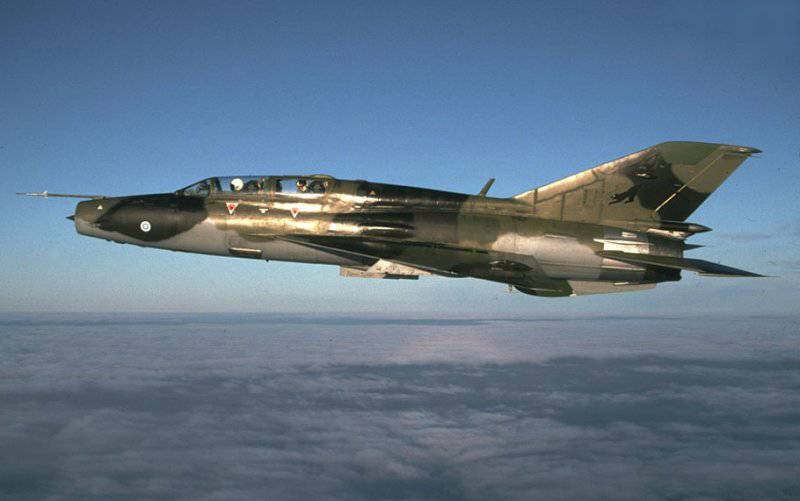
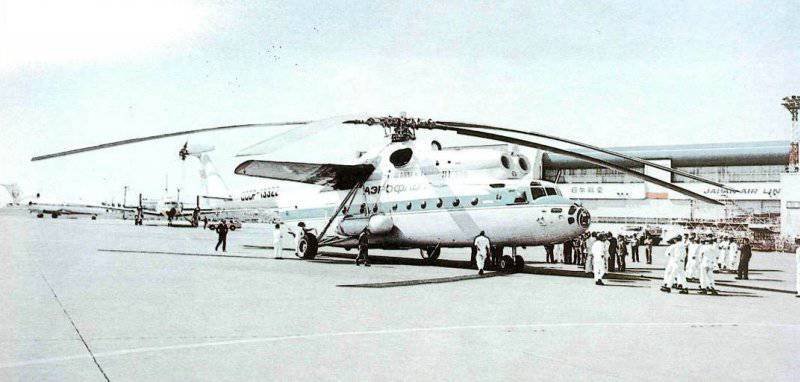
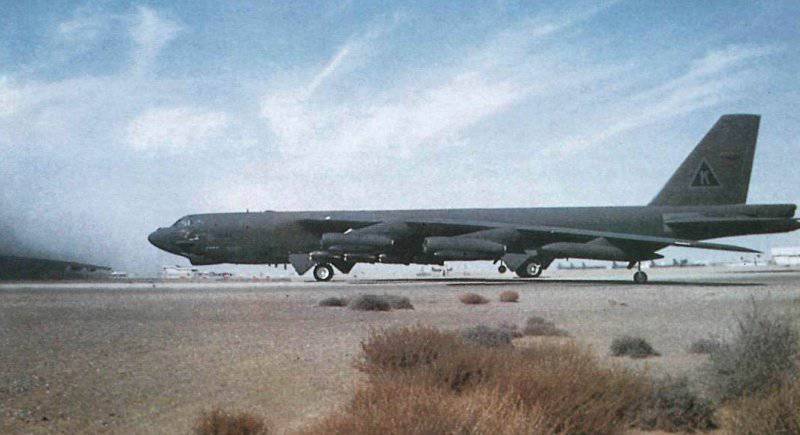
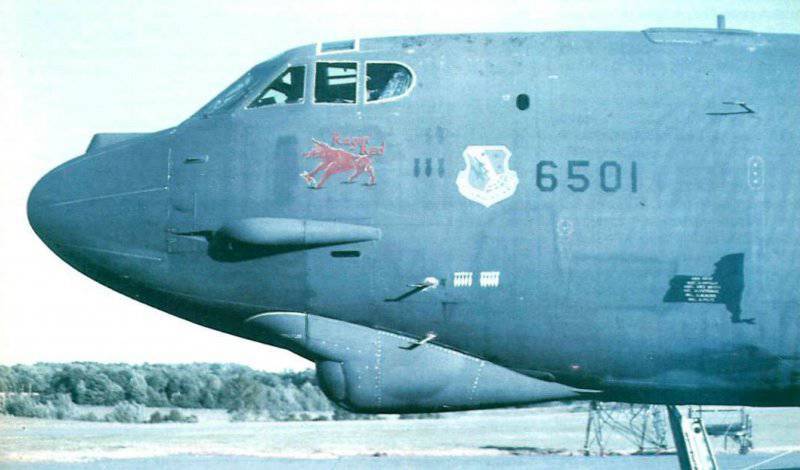
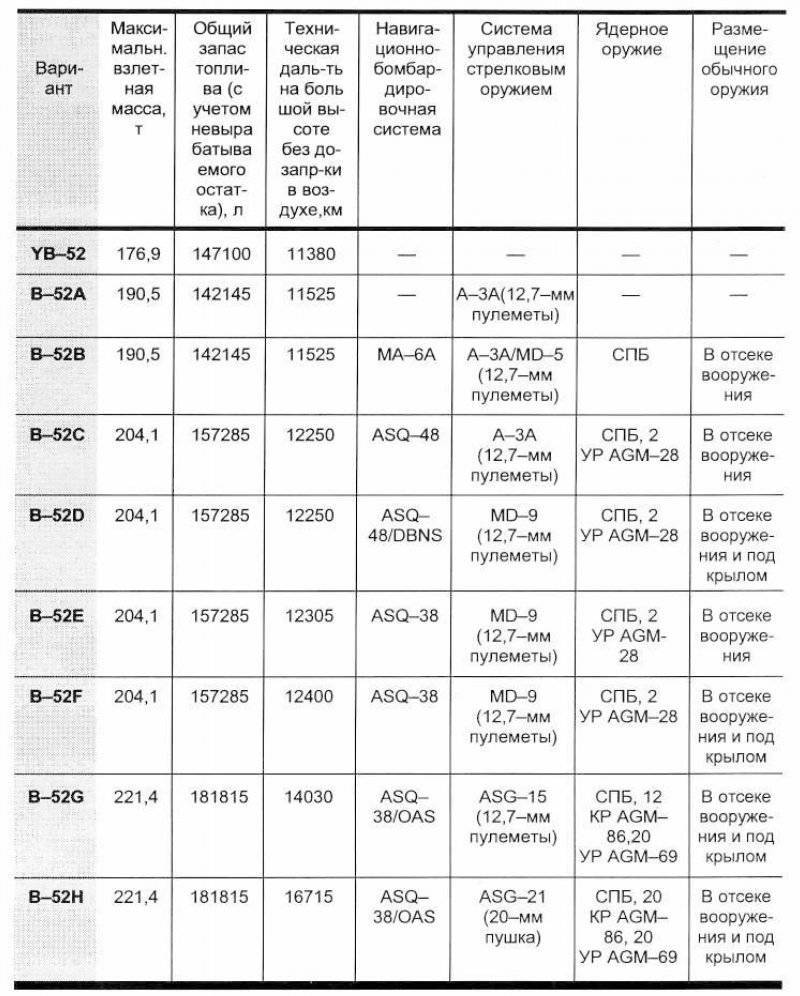
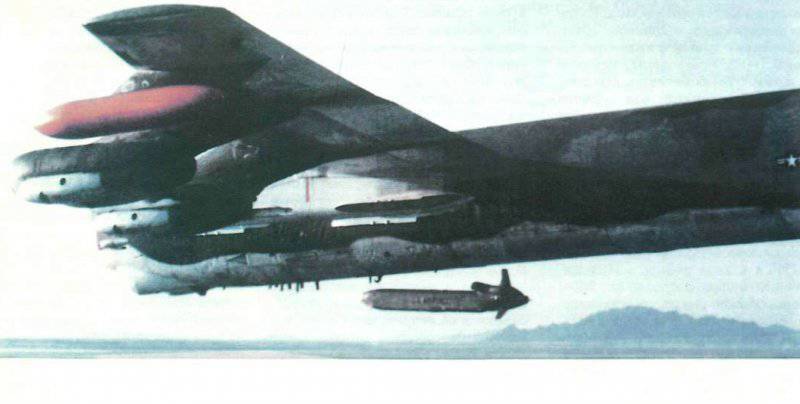
Information